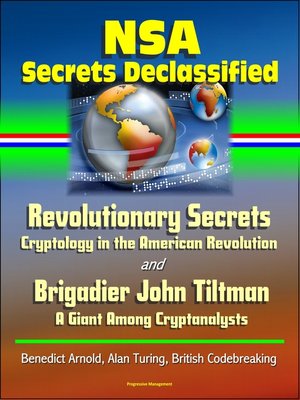NSA Secrets Declassified
ebook ∣ Revolutionary Secrets: Cryptology in the American Revolution and Brigadier John Tiltman: A Giant Among Cryptanalysts--Benedict Arnold, Alan Turing, British Codebreaking

Sign up to save your library
With an OverDrive account, you can save your favorite libraries for at-a-glance information about availability. Find out more about OverDrive accounts.
Find this title in Libby, the library reading app by OverDrive.



Search for a digital library with this title
Title found at these libraries:
| Loading... |
Professionally converted for accurate flowing-text e-book format reproduction, two important NSA publications convey fascinating historical stories: Revolutionary Secrets: Cryptology in the American Revolution and Brigadier John Tiltman: A Giant Among Cryptanalysts.Revolutionary Secrets: This is the story of revolutionary communications and cryptologic secrets and the role they played in America's war for independence. At the time of the American Revolution, both the British commanders and the American rebels practiced a variety of methods to keep their written communications secret. Both turned to invisible inks, hidden messages, and secret writing in the form of ciphers and codes. Cryptography—the use of ciphers and codes—makes messages unintelligible to an adversary by the use of keys and lists. Ciphers rearrange letters or change individual letters into a different letter, number, or symbol based on a prearranged setting known as a key. Codes change entire words or phrases into other words, number groups, or symbols based on a list or a book. To decrypt the secret messages, the receiver needs access to the original key, list, or book. Theoretically, the adversary wouldn't have the original source and therefore could not understand the message even if it were captured. Solving a message without having the original key or list—crypt-analysis—has been employed by governments and militaries for as long as people have used cryptography to make messages secret. The ability to capture and read the enemy's communications provides invaluable information for a military commander. With foreknowledge of an adversary's intentions, leaders can develop counteractions and turn a battle in their favor. In the late summer of 1781, General George Washington finally saw an opportunity to take New York City away from the British. Virtually from the beginning of the War for Independence six years earlier, the British had held this key city, and Washington had long desired to take it into American hands. Washington laid siege to the town all summer. With the expected arrival of Admiral de Grasse and ships of the French fleet along with an additional 3,000 French soldiers, he believed he finally had his chance. But on August 14, he changed his mind and turned his eye to Yorktown, Virginia. Washington received intelligence, gained partially through the decryption of captured British messages, that gave him the assurance he needed to complete his move on Yorktown.Brigadier John Tiltman: Brigadier John Tiltman has been variously described as the greatest cryptanalyst of his time, the best cryptanalyst ever to work for Government Communications Headquarters (GCHQ, Great Britain's counterpart to NSA), and a "legend in his own time." He led the attack on numerous code and cipher systems of over a dozen countries. At the same time, he developed cipher systems for his own country that were unbreakable during the time they were used. He held the title of Chief Cryptographer for the Government Code and Cypher School (GC&CS, which became GCHQ in 1946) from 1942 on. He humbly described this position as "honorary," but it carried the dual responsibility of being tasked with the initial diagnosis of and attack on all unbroken foreign cipher systems, and the development of secure ciphers for British forces. His career spanned two world wars, conflicts in Korea and Vietnam, and most of the Cold War. Retiring from GCHQ in 1964, he capitalized on relations he had built up over the previous two decades and served as a consultant to NSA until 1980. At the age of eighty-five, he finally stepped away from sixty-six years of public service to two countries. Sixty of those years were devoted to signals intelligence...






